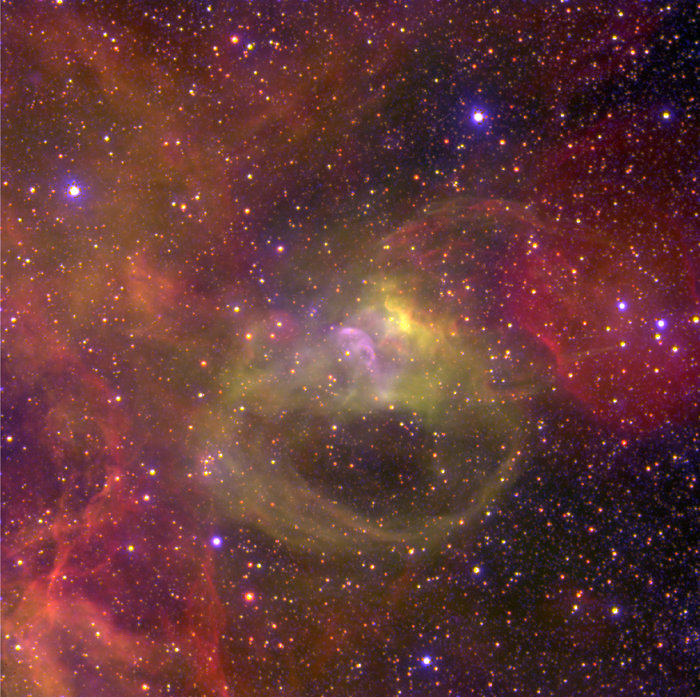Nebulae near the hot Wolf-Rayet star BAT99-2 in the LMC
Three-colour composite image of the highly excited nebula near the Wolf-Rayet (WR) star BAT99-2 in the Large Magellanic Cloud (LMC), obtained in January 2002 with the FORS1 multi-mode instrument at the 8.2-m VLT MELIPAL telescope at the Paranal Observatory (Chile). It is based on three exposures through narrow-band optical (interference) filters that isolate the light from specific atoms and ions. In this rendering, the blue colour represents the light from singly ionized Helium (He II; wavelength 468.6 nm; exposure time 60 min), green corresponds to doubly ionized oxygen ([O III]; 495.7 + 500.7 nm; 5 min) and red to hydrogen atoms (H; H-alpha line at 656.2 nm; 5 min). Of these three ions, He II is the tracer of high excitation, i.e. the bluest areas of the nebula are the hottest. The sky field measures 400 x 400 square arcsec; the original pixel size on the 2k x 2k CCD is 0.23 arcsec. North is up and east to the left. Before combination, the CCD frames were flat-fielded and cleaned of cosmic-rays. Moreover, the stars in the blue (He II) image were removed in order to provide a clearer view of the surrounding nebular emission. The reproduced brightness is proportional to the square-root of the actual intensity; this increases the "dynamical range" of the image, i.e. it shows better areas of very different brightness.
Crédit:ESO
À propos de l'image
| Identification: | eso0310b |
| Type: | Observation |
| Date de publication: | 9 avril 2003 |
| Communiqués de presse en rapport: | eso0310 |
| Taille: | 1918 x 1911 px |
À propos de l'objet
| Nom: | BAT99-2, LMC |
| Type: | Local Universe : Star : Type : Wolf-Rayet Local Universe : Star : Grouping : Binary Local Universe : Nebula |
| Distance: | 180000 années lumière |
| Constellation: | Dorado |
| Catégorie: | Nebulae |
Fonds d'écran
Coordinates
| Position (RA): | 4 49 35.71 |
| Position (Dec): | -69° 20' 48.88" |
| Field of view: | 6.65 x 6.62 arcminutes |
| Orientation: | North is 0.0° right of vertical |
Couleurs & filtres
| Domaine | Longueur d'onde | Télescope |
|---|---|---|
| Visible Heiii | 468 nm | Very Large Telescope FORS1 |
| Visible Oiii | 495 nm | Very Large Telescope FORS1 |
| Visible Oiii | 500 nm | Very Large Telescope FORS1 |
| Visible H-alpha | 656 nm | Very Large Telescope WFI |

